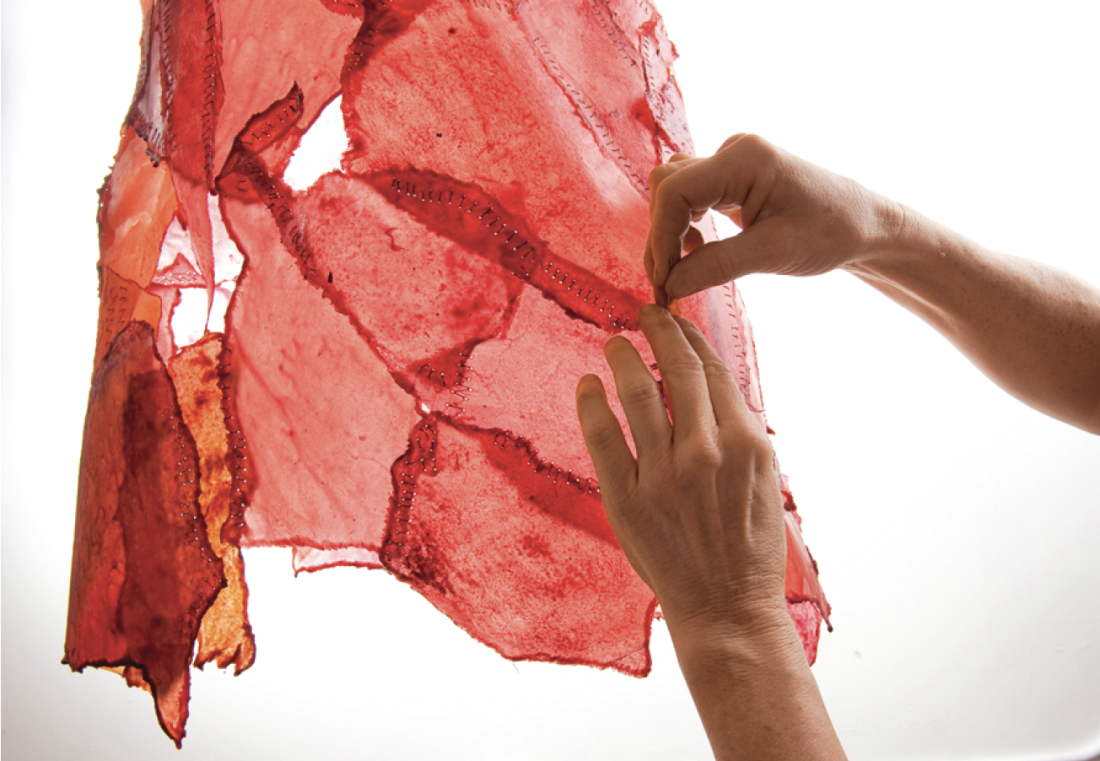Deb Thompson
Deb Thompson’s work, exhibited under the exalted and seductive title “Tales from the Underworld,” wants to charge and tackle the viewer’s psyche viscerally, drawing out gut responses to its destabilized mix of imagery. The narratives are intuitively organized around an adopted language of myth; emblems from the Egyptian Book of the Dead and references to Greek figures, like Persephone, move in a frenzy across the surfaces of the paintings. A haphazardness results, in one sense thematic and in another problematic. I was never entirely certain about the ultimate direction of the painting; there is an in-betweeness that stalls the work on important levels. Elements of enshrined symbols are audaciously mixed and matched but the allegorical import becomes unclear, and their cultural inheritance as still-resonant fabrications is left unexplored (think of Nancy Spero’s or Kara Walker’s work and their overturning of historical material). The subject of the artist as character and author of this journey through the underworld is indicated more than palpably expressed, but while I don’t doubt the strength of emotions that brought the work into being, neither do I find myself sensing an emotional relationship to it.

Deb Thompson, Rubedo: Pomegranate Dress, 2008, installation detail from “Tales From the Underworld” at Touchstones Nelson, rice paper, beeswax, red dye. thread, 34 x 54”. Photograph: Jeremy Addinton. Courtesy Touchtones Nelson Museum of Art and History.
“Tales From the Underworld” consists of three groups of work, titled “Going to Hell” and “Door into the Sky,” which are paintings, and “Coming Forth by Day,” which are sculptures—a series of dresses, elegant and macabre. A trio of red spectral dresses suspended at the entranceway check you like the frightening Ammit who welcomes the newly arrived to the afterlife. One symbolically bloodied dress is complete and titled Pomegranate, 2008; the other two are tattered remnants and are called Menstrual. These are the most gripping works in the show, proof of an artistic intensity. They encapsulate clearly and concisely the coexistence of constructive and destructive forces, that axis on which Thompson’s work, current and past, is made. These red dresses (more so than the others in the show, which are white and black) knitted from patches of ricepaper soaked in beeswax, are tactile and intense—almost more than they themselves might know, which is interesting, meaning they can be imagined beyond the inert state in which they hang. The metaphorical flesh they embody belongs to that body, that personhood of meta-conflict and transformation, of form and dismemberment, flesh and evisceration and, by extension, the mythical realization of existence/non-existence. We also remember Persephone, queen of the underworld, tricked by her abductor Hades into eating the pomegranate; her resulting imprisonment, and how Demeter, her mother, instituted a period of time (menstrual flow) each year during which nothing would grow.
And here we do identify with the artist and the aesthetic voicing of an act of survival, the spirit exposed and protected by blood-soaked ritualistic cloth.
The vividly coloured paintings abound with reference: to mythology, expressionist painting, Surrealism and sexuality. But these tangents are indicated rather than deeply explored and hover in that in-between state I referred to earlier, leaving the viewer to guess too much, to resolve the dilemma by positing a textual narrative outside the visual surfaces, which themselves then become passing illustrations. I think of the paintings of Neo Rauch as a contemporary comparison of a developed surrealistic style.
The problem may lie in the fact that the paintings hastily grasp at their materials in general: the concepts, the imagery, the drawing. The figurative elements sit on the surface in an almost illustrative way. Why is there such rushing? The work may be somewhat unresolved, which the irresolution of a journey through the underworld in and of itself does not support. Nonetheless, Thompson’s work bravely takes its chances, however it seems to arrive before it gets there—for now. ❚
“Deb Thompson: Tales From the Underworld” was exhibited at Touchstones Nelson Museum of Art and History, Nelson, from April 21 to July 08, 2012.
Tom Hardy is a poet and writer living in Nelson, BC.

